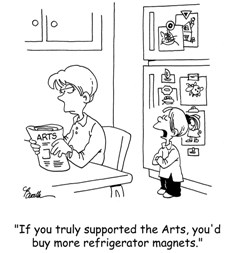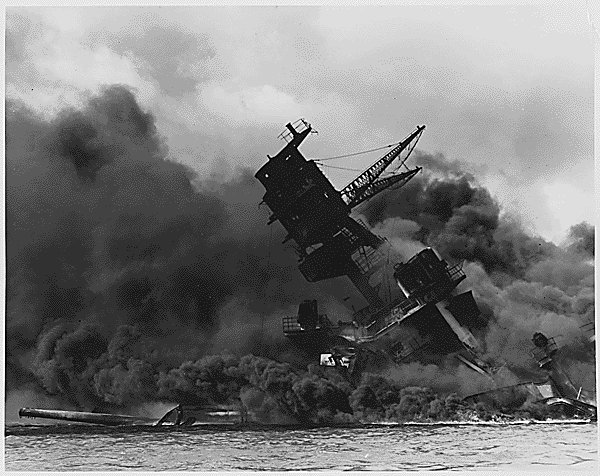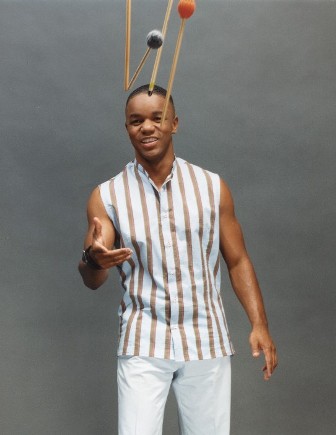Dewey 21C: October 2008 Archives
It's the mother lode. It's the conversation you point towards, hope for, well beyond the technicalities of a school principal administering an arts education program.
We got to talking about the age old issue of works that have passed the test of time, considered to be masterpieces, versus newer works often by living artists, that are rejected outright or overlooked by those who are guided by a magical catalog of masterpieces.
We talked for a while about the great length of time it took for Mahler's works to enter the mainstream--to be accepted by audiences as masterpieces. These works, written at the turn of the 20th century, took a good 70 years or more to truly enter the classical canon.
We talked about Bach all but disappearing until Mendelssohn resurrected Bach (Mahler pun intended) among classical music enthusiasts of the 19th century.
We talked about the people who still question Jackson Pollock. We talked about Buster Keaton, and the many years his body of works languished, until James Agee's 1949 Life Magazine piece put Buster's genius back on track.
It all got me to thinking about how I learned to love Steve Reich.

The vast majority of Western music has a similar architecture or design. It's there in a Strauss opera, as well as a great song by Gershwin or even a phrase of Woody Guthrie. The music of Steve Reich does not make use of that architecture. Its influence comes from Africa. It has a steady pulse, and phrases that appear to be repeating themselves, over and over. Reich describes it as 'pulsatile." In fact, these repeating phrases contain small, almost imperceptible changes that alter the music subtly over time. I would argue that if you can hear these changes, than you really aren't taking the music in.
Are you still with me? Okay, here's the deal: Reich's music does not employ the narrative that is prototypical to most Western music. If you're looking for the building of phrase, harmony, rhythm to an emotional peak, well, you won't find it in Reich's music. If you're listening for that Western narrative, you are SOL. You will find something else which asks you to receive the music in a different way.
In the mid-eighties, one of my dearest friends, freelance trumpeter Terry Szor, gave me a cassette of Music for Eighteen Musicians. He told me that it "changed my life." It's the turn of a phrase I have heard spoken about Reich's music so very, very often. So, I tried it on for size; I hated it.
I was listening for that Western narrative. In arts education, artists and teacher often work with the parallels between the architecture of sentences and paragraphs in literature (English Language Arts) and music. Naturally, settings of literary works to music, such as Schubert lieder, reinforce this relationship. That being said, if you were to compare Reich's music, or Coltrane's Interstellar Space or Sun Ship to such literary works, you might not know where to start. I chose thse examples because Reich was influenced by the later, "experimental" works of John Coltrane, which are rarely mentioned against Coltrane's more traditional works, such as the beloved Blue Train or My Favorite Things.
God, this is a long blog....I hope you'll read it!
So, here I was listening with my Western ears, getting supremely bored (Coltrane pun intended), getting annoyed, and I quickly bailed, wondering what exactly was wrong with my friend Terry. Years later, after I finally learned to love Steve Reich, I played a recording of Drumming for another close friend, who got mad and instructed me in no uncertain terms to turn it off, immediately!
The first time I remember really finding my way with Reich's music was at a dance performance. There was something about following the dance, the visual aspect, that allowed me to take the music in, in an entirely different way. I wasn't listening for a certain progression, a certain phrase, a certain architecture--all the things I had been trained to listen for in music, but instead I felt the music, received it--allowed it to wash over me. Watching the dance made it possible. It was as if a switch was flipped.
This letting go of my intellectual ear, my thinking ear, perhaps better put, led me to a place where the music created a feeling that I could only describe as euphoric and trance-like, if, and only if I really gave in to it. Time and space sort of stopped, and I connected with the genius of Steve Reich. I learned to love Steve Reich.
It's what makes this question of quality difficult to answer in the simple way that an educator might like. Not to mention the question of assessing knowledge. Can't we create a rubric for this? The rubric of genius! How could it be that I moved along a continuum of experience and learning to evolve from someone who wanted Reich's music to stop, to someone who experienced a physical euphoria while listening to the work, wishing the music would never stop?
And, this isn't limited to Reich. To this day, I hear from the people who tell me that John Cage's genius is for his "ideas," not his music. Oh really?
I want to tie this back to education. Arts education, as well as education in general. The complexity of this matter, the kaleidoscope of quality, in so many ways speaks to the complexity of teaching and learning, and of course, how we evaluate, test, measure, and establish systems of accountability.
Is Andy Warhol genius or charlatan? Is Reich a genius or annoying? Can standardized testing ever be an effective measure for understanding a complex world of teaching, learning, and human development? Perhaps when that task force or administrator gives us our rubric of genius we will know for sure. And for those who think I am kidding, believe me, that rubric is being worked on somewhere, someplace.


Buyer beware: this is not a brief blog...
Last Tuesday, the New York City Department of Education released its second Annual Arts in the Schools Report, which is part of a larger initiative called Arts Count.
There were three press articles that covered this report:
NY Times
NY Post
Inside Schools
Here is the press release issued by the NYCDOE
Okay, what are the key points that made it to the press release?
"Among
the main findings:
·
Forty-five
percent of elementary schools offered all four art disciplines in 2007-2008, up
from 38 percent in 2006-2007.
o
92
percent of elementary schools offered visual arts
o
89
percent of elementary schools offered music
o
percent
of elementary schools offered dance
o 56 percent of elementary schools offered theater
·
Thirty-three
percent of middle schools offered all four art disciplines, up from 17 percent
in 2006-2007; and student participation increased in all four disciplines.
o
91
percent participated in visual arts programs, up from 84 percent
o
75
percent participated in music programs, up from 69 percent
o
57
percent participated in dance programs, up from 36 percent
o 56 percent participated in theater programs, up from 49 percent
·
A
greater percentage of high school students are participating in arts
instruction by discipline.
o
In
the 9th grade, student participation in dance, theater, and visual
arts increased by more than ten percentage points in each discipline.
o
In
the 10th grade, student participation in dance, music, theater, and
visual arts increased by more than six percentage points in each discipline.
o
In
the 11th grade, student participation in dance, music, and theater increased
by more than five percentage points in each discipline.
o
In
the 12th grade, student participation in dance and theater increased
by at least ten percentage points.
The
report also shows that despite budget constraints, school leaders reported
hiring an additional 152 certified arts teachers. Spending levels remained
essentially unchanged.
Last
year, the Department of Education used several approaches to enhance access and
participation rates. These included:
·
Establishing
the Arts Education Liaison position in more than 1,200 schools. The Arts
Education Liaison assists the principal in planning arts instruction, choosing
cultural partners, and completing the Annual Arts Survey;
·
Building
awareness of the requirements for arts education, resulting in a higher survey
response rate. The 2007-2008 response rate was 91 percent, representing 1,307
schools, compared to 75 percent, representing 939 schools, in 2006-2007;
·
Offering
technical assistance and support to every school. More than 800 schools
accepted and received help in implementing arts programming;
·
Identifying
schools in need of improvement in arts education programs and providing
specific support services such as visits to best practice sites, seminars on
budgeting and scheduling, and an introduction to the Blueprints for Teaching
and Learning in the Arts--a research-based approach to teaching arts
implemented under Children First."
The number of schools without any arts teachers jumped from approximately 20% to almost 30%. (There are almost 1500 schools in the system--you can do the math.)
Spending on arts supplies went down by 63% (a reduction in almost $7 million). That's a whole lot of supplies.
Spending on services of cultural organizations went down by over $500,000. If you factor in that cultural organizations match the contributions of schools by two dollars for every one dollar a school spends, you're looking at total reduction in $1.5 million related to services provided by outside organizations. This is particularly important when you consider the dearth of certified arts teachers.
The number of arts teachers at the middle school level declined, as well as overall spending at the middle schools. But, somehow the number of students provided with the minimum state requirements in arts education jumped from 29% in last year's report to 46% in the new report. While it is not impossible for this to have occurred, it's a bit of a head scratcher.
Even after what many believe to be the largest budget increase in the history of New York City public schools, from approximately $12 billion in 2003 to almost $20 billion at present, you have only 8% of all elementary schools even in the position to provide the minimum State requirements, by offering all four art forms in all grades. Granted, last year only 4% met this criterion. Yes, you have a 100% increase. And at that rate, it will take how many years to meet the requirements for all students? The answer is four years. But not so fast. We're talking about offering what amounts to the minimum requirements, not rates of participation. Nevertheless, if this rate of increase could be sustained, that would be a very important win for the children. Wouldn't it be grand if the City of New York pledged to maintain that rate of growth, for even if it doesn't give us 100% participation, it would be a foundational growth in capacity.
The press release indicates that 152 new certified arts teachers were added. Sounds great? Only it's not the whole story, as a review of data in the report indicates an increase of 61 teachers. How is that possible? Well, we surmise they don't factor in the number of positions lost to attrition. In all fairness, that is still 61 new teachers. That being said, these positions were added during the historic budget expansion period. This is also an example of how the data can be misleading. Sixty-one teachers were added while there was a 10% increase in the number of schools without certified arts teachers. Our interpretation is that some arts friendly principals used their increased budgets to hire more arts teachers, while many principals that had one certified arts teacher on staff cut back to zero.
The report indicates that "per capita" spending rose from $308 to $311 per student. (Actually, last year's report states the spending was at $312). Again, it sounds great, doesn't it? Where else in the country are they spending $311 per student? If you consider that there are hundreds of schools without a certified arts teacher, how could the per capita spending be $311? Certainly, if you add up all spending attributable to arts education, and divide it by the number of students, you can calculate such a per capita figure. But this doesn't really tell us much of the story, as to who is provided with what. What is the per capita spending in a school where the kids haven't a single certified arts teacher and spending on cultural providers is being cut, versus spending at the Frank Sinatra School of the Arts High School? This is an area that needs much greater attention.
The section on response rates of schools is another head scratcher. Last year's report stated that only 1078 schools were included in the report, even though the initial response rate was over 1200 schools. This year's reports state that last year's response rate was only 939 schools. If last year's report factored data from 1078 schools, how could it only have 939 responses?
It's also interesting that both this year and last year's report give the impression that all high school students receive the arts education required by the State of New York. This is because one cannot graduate without one year of arts education. That is, roughly speaking, the minimum requirement. However, if you consider graduation rates, as well as alternative pathways to high school diplomas, well, many high school students are not being provided with arts education. It is another area, a significant one, warranting a different methodology.
This is a particularly important area of concern. Upon analysis of last year's report, we determined a clear statistical correlation between those who study the arts, and attendance and graduation rates. In a system struggling to raise graduation rates, it would appear that participation in high quality arts for all high school students on a regular basis would be an important approach to raising the graduation rates.
The report is hobbled by much of what ails many of the similar reports being released elsewhere: it is heavily weighted towards explicating what is "offered," without going the next very hard mile to determine real rates of participation. As long as these reports tell us, in the main, what is "offered" but do not apply more sophisticated and costly methodologies to uncover participation to a much greater degree, a veil will remain over the data and its utility.
Finally, for a report of this importance, most of the researchers I have spoken with have stated that there should be some independent verification of the data provided by the principals. Almost everything is self-reported, with internal verification by the NYCDOE data. Perhaps a sample of schools might have been selected for site visits and detailed auditing of data for verification purposes?
Everyone I know feels that the NYCDOE Office of Arts and Special Projects, led by Interim Acting Executive Director Paul King, is doing the very best job possible under policies they do not control. I certainly feel that way.
You must remember that this report, for all intents and purposes, reflects another time and place, before Wall Street and Main Street started tumbling. What will safeguard the arts in New York City schools, especially when the grade scores given each school, to which principal accountability is based, do not reflect the arts in any real, meaningful, and practical way. When budgets start to tumble, and with the rubber meeting a road paved with ELA and math scores, what will happen to the arts?
All in all, I would have to say this the report has a through the looking glass quality that doesn't provide the real tools we need, namely a detailed understand of what each child receives and what it will take to get us to a well-rounded education that includes the arts for every child, while meeting the minimum requirements required by the State of New York.
Thanks to my colleagues Doug Israel and Kira Raffel at The Center for Arts Education with assistance in putting what should have been a multi-part blog into one post.
Okay, for those who had the patience to read through the entire post, here's a pop quiz: What do you call a watch dog that doesn't bark or bite? Email me with your answer and don't forget your number two pencil.
 Okay, I know, it makes no sense. Why would we pay kids to study arts education when they like studying the arts, it has a positive effect on attendance, and in many districts across the nation, kids are denied access to arts instruction?
Okay, I know, it makes no sense. Why would we pay kids to study arts education when they like studying the arts, it has a positive effect on attendance, and in many districts across the nation, kids are denied access to arts instruction?I was just trying to get your attention.
If you haven't already heard, paying kids to take tests, improve performance, and attend school is the next wave of "school reform." There are also programs to pay parents to make sure their kids attend school, take tests, etc.
Diane Ravitch, the leading education historian in the United States, among other formidable accomplishments, has written a piece on this issue for forbes.com.
Click here to read it. If you do, you'll get a $1.00 check in the mail!
And you thought the debates were over. This will be a good one. Click here to register.
Education and the Election
Two must-see events on edweek.orgLive Debate: Education and the Next President
Exclusive webcast, Tuesday, October 21, 7 p.m. to 8:30 p.m. Eastern
time
Live from Teachers College, Columbia University: "Education and the Next
President," a debate between Linda Darling-Hammond, education adviser to
Democratic nominee Barack Obama, and Lisa Graham Keegan, education adviser to
Republican nominee John McCain.

Overlooked among the media coverage on Doctor Atomic is the support provided for those who want to learn more. When it comes to opera, I have long admired John Adams for creating works that have direct relevance to my life and times. Don't get me wrong, I admire John for his music and his increasingly important role as a musical ambassador. In fact, John is a friend of mine. That being said, his operas are about a world I know, my world, and while I always appreciate the universal quality of timeless operas and other musical works, there is something more broadly satisfying when it come to a work that has a true, bulls-eye quality when it comes to cultural relevance.
So, here you have a work with so very many opportunities to explore that cultural relevance: history, science, politics, and more, all connected to some of the most striking figures of the 20th century, including J. Robert Oppenheimer and Harry Truman.
This work was crying out for a broad-based approach to education and outreach, and the Met Opera and Met Opera Guild has done one bang up job.
Click these links to see all that the Met Opera and Met Opera Guild have to offer, including:
Science and Society--Explore the impact of the bomb on science, the arts, current events, and more.
Doctor Atomic Events
The Doctor Atomic Blog
Doctor Atomic Study Guide

"I am become death, the destroyer of worlds." J.Robert Oppenheimer as he witnessed the first successful test of the atomic bomb.
Exploratorium's Doctor Atomic Website
Oppenheimer recalls the moment

Over the past year or two we've seen the emergence of significant studies to determine the levels of access to arts education by students in a given state or in some instances a city. Later today, the New York City Department of Education will release its second Annual Arts in the Schools Report. This year, they're not inviting press to the release. More on that report later this week.
I came across this
study by the Colorado Department of Education and the Colorado Arts Council.
Click here
for the full report
Click here
for the beautifully prepared summary
Not surprisingly, the study finds "that while most schools offer some formal arts education to a majority of students, an estimated 29,000 students attend public schools that do not offer any formal arts education."
Importantly, "offer" only tells us so much. There is always a major gap between what's offered and what is received. For instance, in some research related to a Wallace Foundation grant to the NYCDOE, it was estimated that while 50% of the middle schools "offer" dance, only 10% of the students receive it.
The study
also claims that "new data reveals that
Naturally, these finding are not about "transference" of arts education to reading, writing, and science. They are looking at statistical relationships between students who study arts and their grade scores in certain subject areas, as well as dropout rates. We've seen these claims before, particularly in regards to SAT scores and the number of years a students studies music in high school.
Nevertheless, the more we have to understand the state of access to arts education, the better the position we are in to advocate.
If you're interested in this area, be sure to look at both the SRI report for the Hewlett Foundation and the census report done of all schools in the State of New Jersey.

Among the charter school movement, it is central to what I find most appealing: starting from scratch, with bold ideas that will likely not be encumbered by district or SED bureaucracies. If one has an idea for what would make a great school, and you can put it together through the various means available for creating a charter school, well, there's something quite extraordinary in the opportunity it provides and the potential lessons to be shared among schools that do not have similar freedoms. Many argue that it is, in fact, the R&D for K-12 public schools across the United States.
However, a few issues emerged during that lunch that I found troubling. The first was ideological: it was pretty clear that this principal was out to prove to the public schools that charter schools could do it better. It gave me pause, as I have a natural predisposition against ideologues. I mean, are these people about their kids or proving other people wrong? Capice? While I understand that the two are not necessarily mutually exclusive, it still makes me wonder.
The second had to do with the funding and governance structures in place. This principal was seeking some advice on building her board and establishing an individual giving program. I thought: WTF? While building new grades and all of the other substantial requisite capacity, there was board development and fundraising as well. When I heard about the amount of money that had to be raised from private sources, I realized that we were talking about something eerily similar to a typical 501 (c) (3). I wondered how they would possibly develop that fundraising arm, and also wondered what would happen once they had the inevitable shortfall? Would they fire teachers? Cut programs? Delay adding that grade level to get make it a K-5 school?
Well, today there is an article in the New York Times that focuses on the highly respected Harlem Children's Zone where the failures of Washington Mutual, Lehman Brothers, etc., have left a big hole in their budget.
Of course, budget cuts happen to school systems. However, if you've ever worked in a non profit, you know there is something quite different in the ways income in generated in a non profit versus the ways in which public schools receive their budgets. For instance, what happens when a big donor drops out, in good or bad times? What happens when your board chair leaves or other leadership transition occurs that may effect income? In a public school, that is a relative non-issue when it comes to income. In a charter school, it's an issue. Not to mention that your non profit is now directly competing with those charter schools, for board members and contributions, in case you haven't considered that.
Yes, it's true, the charter school can always seek to convert to being a public school, or perhaps better put, become part of the public school system/district.
There is another New York Times piece which looks at a charter school that is planning to pay their teachers $125,000 a year. Again, consider that this part of the R&D has to be paid for primarily out of contributed income (donations).
With the economy heading in a direction no one seems to be able to understand, beyond Warren Buffett calling it an economic Pearl Harbor, it will be interesting to see what happens to charter schools in this climate.

 I have had the good fortune to be associated with Chamber Music America's New Music Institutes, which are a series of institutes across New York State providing professional development for students, professional artists, and managers in connection with the creation, performance, and promotion of new chamber music.
I have had the good fortune to be associated with Chamber Music America's New Music Institutes, which are a series of institutes across New York State providing professional development for students, professional artists, and managers in connection with the creation, performance, and promotion of new chamber music. Last week at SUNY Potsdam, I was deeply struck by one of the faculty members: Stefon Harris. Stefon is a great jazz musician, ensemble leader, teacher, and musical citizen.
As part of his work with the institute, Stefon and his ensemble, Blackout, gave a workshop for Crane School of Music students on how to listen and identify jazz harmonies based on how the chords made them feel. I know it sounds hackneyed, but it was indeed brilliant. His approach was masterful, touching, and extremely connected to deep meaning in music.
It was an amazing example of a truly gifted musical communicator--someone who not only has the innate gift to speak directly, powerfully, and persuasively to people about what might arguably be considered abstract musical terms and concepts, but has developed his own voice and approach to connecting music to people. In other words, he has the gift for communicating verbally and through music, and has developed his own highly refined system of organization/concepts.
I know it sounds like hyperbole, but trust me, Stefon has Bernstein-like abilities in this regard.. He's the real deal: a truly gifted musician and composer, who is also truly gifted at making music accessible to anyone.
Margaret Lioi, CEO of Chamber Music America, has been talking to me for a number of years about Stefon's work with audiences on how to listen to jazz. This was my first chance to hear him and it was a truly remarkable. Margaret was spot on in what she had been telling me about Stefon.
I am looking forward to seeing how this great young artist continues to develop, and I hope that his gifts will be put to great use beyond simply booking him and his ensemble. I could imagine Stefon training teaching artists, or being given space on any number of performing arts series to perform and engage audiences.
And, his group is also terrific. One of the last pieces they played just took my breath away. It was Sting's Until. Wow!
If you don't already know Stefon Harris, I am happy to introduce him to you:
www.stefonharris.com
 I always thought he was underestimated as an actor. It wasn't just as measured by the number of Academy Awards, but rather by the opinions of all my friends that he wasn't on par with Marlon Brando, Robert DeNiro, Gregory Peck, Lawrence Olivier, etc. I argued then and will argue now.
I always thought he was underestimated as an actor. It wasn't just as measured by the number of Academy Awards, but rather by the opinions of all my friends that he wasn't on par with Marlon Brando, Robert DeNiro, Gregory Peck, Lawrence Olivier, etc. I argued then and will argue now.I know it sounds terribly corny, but when I heard of the death of Paul Newman I felt that I had lost a friend. (I felt that way about George Carlin, although with Carlin, it left me wondering who would tell us all how stupid we are, do you hear that Lewis Black?) Is it that some of the first movies I saw with my family starred Newman, like Somebody Up There Likes Me? Is it that Butch Cassidy and the Sundance Kid was released during the period when I started to really connect to feature films?
There are just so many of his performances that I gravitate towards, and watch again and again:
The Verdict
Hud
Slap Shot
The Long Hot Summer (where he gives the great Orson Welles quite the run for his money)
Nobody's Fool
Where the Money is
The Hudsucker Proxy
Mr. and Mrs. Bridge
Fort Apache The Bronx
Buffalo Bill and The Indians
The Drowning Pool
Sweet Bird of Youth
The Life and Times of Judge Roy Bean
The Sting (which introduced me and many others to Scott Joplin)
The Color of Money
Cool Hand Luke
The Hustler (my first time seeing The Great One playing in a non-comedic role)
and finally, a real sleeper, rarely mentioned, but a terrific comedic turn fairly early in his career:
What a Way to Go!
In an age of celebrity, Newman through his philanthropic work, as well as his ever charming self deprecation, always reminded us that he did not stoke nor covet his celebrity. What a mensch.
Even his small posse of stars and character actors, from Robert Redford to Strother Martin, whom appeared as a character actor along with Newman in so many of his great films, says a lot about this great man we lost last week.
In the 80's, I used to see films in an old fashioned movie theater near Lincoln Center that was a revival house: The Regency. (It's now a Victoria's Secret.). One night at The Regency I was watching The Long Hot Summer for the very first time. There's a scene early on in the film where Newman appears shirtless in glorious color, and I remember a woman letting go with a huge loud sigh of joy, at the sheer beauty of Paul Newman. The full house erupted with laughter and then with applause, for what was then an almost 30 year old film.
Here are two links, the first from an ABC new piece where a number of movie stars comment on the life of Paul Newman; the second is Maureen Dowd's piece from yesterday's New York Times.
Stars Speak Out About Paul Newman
Cool Hand Paul
 Looking at the ashes being scattered across Wall Street, the extent to which we do not yet understand or can reasonably predict, made me think a bit about what it was like going into the public schools as a "teaching artist" during the early to late 1980's.
Looking at the ashes being scattered across Wall Street, the extent to which we do not yet understand or can reasonably predict, made me think a bit about what it was like going into the public schools as a "teaching artist" during the early to late 1980's. Okay, I am not completely sure that the term teaching artist had quite taken hold as early as 1982. I was then a student at The Juilliard School and was recruited to be part of a program then called, if my memory serves me, the Lincoln Center Student Program, that I believe had a connection the what was then a very young Lincoln Center Institute. I was part of a small musical ensemble that was sent into the schools to perform for auditoriums full of K-12 students. We received no training. In fact, there was practically no preparation whatsoever. Seriously. We were booked into the schools, and just went in and played for anywhere up to say 1000 kids. It was pretty freaking wild.
Jump forward a few years later, I was working with a chamber ensemble that was part of a number of organizations that also sent us into schools and in community settings, for auditorium programs (lecture-demonstrations) and residencies, including New York Young Audiences, New Jersey Young Audiences, Lincoln Center Meet The Artist, and Carnegie Hall Neighborhood Concert Program,
By the time we made it to the Young Audiences rosters, we had started to receive training from Kathleen Gaffney and Mitchell Korn. There was an extremely talented program director at New York Young Audiences, Tom Bellino, who helped us immensely.
What I remember most about these early days, was that a large number of the New York City public schools and many of the New Jersey urban schools had little to no arts education. Our 45 minute programs, which were part of a series of such offerings across different art forms that a school might purchase were just about all these kids got.
I remember just so well, kids hanging on to us after the gig, wanting to talk, to hear us play more, to ask more questions, to touch the instruments. We had to peel ourselves away. I remember too that we would get terribly depressed after the programs, knowing that these bright eyed children were being denied.
This wasn't all that many years after the cataclysmic events of 1975-1976, where NYC almost went bankrupt and 15,000 teachers were fired. It ripped the heart out of a well-rounded education for urban school students in New York City, and we are still struggling today to make it right. By the time we had hit the schools as teaching artists, many programs had disappeared or declined. High schools that had managed to keep arts teachers saw the results of cuts to junior high schools: students unprepared for arts education at what had been the generally accepted level of high school instruction. This, of course, only led to cuts at those high schools. One big event, followed by years of continued decline, wreaked havoc on arts education in the largest school system in the United States.
Even today, there are estimated to be near 300 schools in the New York City public schools without even one arts teacher. And that's after a school budget that increased from $12 billion to almost $20 billion.
So, it's difficult to not to wonder about what shoes will be next to drop. What exactly will last year's 1.7 percent cut to the school budget, combined with this year's 2.5 percent cut, followed by next year's 5 percent cut, and the reasonable likelihood of even deeper cuts to the school budget (and overall city spending), mean to arts in the schools (not to mention artists and arts organizations).
On one hand, while the mayor promised that no one subject would be singled out for cuts, they have also made it clear that reading and math were the real priorities. There have been promises that principals would be held accountable for providing the minimum New York State requirements, but such accountability was deferred, during much more quaint times last year when the budget was not a big issue.
So, I wonder, how will arts education fare? How far have we come, across the country, in building stronger support for the arts. Will we be seeing 1975-1976 all over again?

